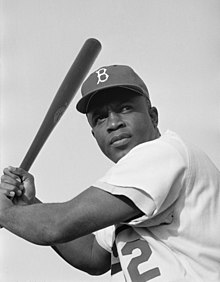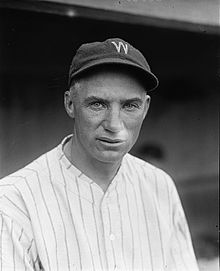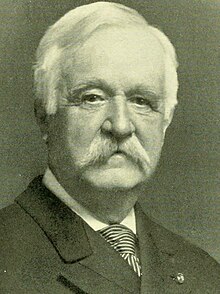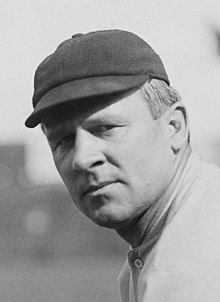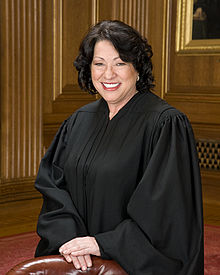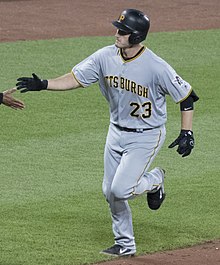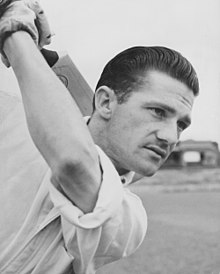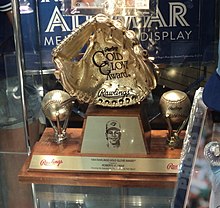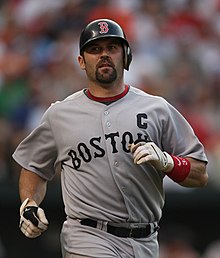Portal:Baseball
Portal maintenance status: (June 2018)
|
| Main page | Content, Categories & Topics | WikiProjects & Things you can do |
The Baseball Portal
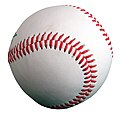
Baseball is a bat-and-ball sport played between two teams of nine players each, taking turns batting and fielding. The game occurs over the course of several plays, with each play generally beginning when a player on the fielding team, called the pitcher, throws a ball that a player on the batting team, called the batter, tries to hit with a bat. The objective of the offensive team (batting team) is to hit the ball into the field of play, away from the other team's players, allowing its players to run the bases, having them advance counter-clockwise around four bases to score what are called "runs". The objective of the defensive team (referred to as the fielding team) is to prevent batters from becoming runners, and to prevent runners advancing around the bases. A run is scored when a runner legally advances around the bases in order and touches home plate (the place where the player started as a batter).
The opposing teams switch back and forth between batting and fielding; the batting team's turn to bat is over once the fielding team records three outs. One turn batting for each team constitutes an inning. A game is usually composed of nine innings, and the team with the greater number of runs at the end of the game wins. Most games end after the ninth inning, but if scores are tied at that point, extra innings are usually played. Baseball has no game clock, though some competitions feature pace-of-play regulations such as the pitch clock to shorten game time.
Baseball evolved from older bat-and-ball games already being played in England by the mid-18th century. This game was brought by immigrants to North America, where the modern version developed. Baseball's American origins, as well as its reputation as a source of escapism during troubled points in American history such as the American Civil War and the Great Depression, have led the sport to receive the moniker of "America's Pastime"; since the late 19th century, it has been unofficially recognized as the national sport of the United States, though in modern times is considered less popular than other sports, such as American football. In addition to North America, baseball spread throughout the rest of the Americas and the Asia–Pacific in the 19th and 20th centuries, and is now considered the most popular sport in parts of Central and South America, the Caribbean, and East Asia, particularly in Japan, South Korea, and Taiwan. (Full article...)
 Featured articles - load new batch
Featured articles - load new batch
-
Image 1Paschal before a game during the 1925 New York Yankees season
Benjamin Edwin Paschal (October 13, 1895 – November 10, 1974) was an American baseball outfielder who played eight seasons in Major League Baseball from 1915 to 1929, mostly for the New York Yankees. After two "cup of coffee" stints with the Cleveland Indians in 1915 and the Boston Red Sox in 1920, Paschal spent most of his career as the fourth outfielder and right-handed pinch hitter of the Yankees' Murderers' Row championship teams of the late 1920s. Paschal is best known for hitting .360 in the 1925 season while standing in for Babe Ruth, who missed the first 40 games with a stomach ailment.
During his time in baseball, Paschal was described as a five-tool player who excelled at running, throwing, fielding, hitting for average, and power. However, his playing time with the Yankees was limited because they already had future Baseball Hall of Famers Ruth and Earle Combs, and star Bob Meusel, in the outfield. Paschal was considered one of the best bench players in baseball during his time with the Yankees, and sportswriters wrote how he would have started for most other teams in the American League. He was one of the best pinch hitters in the game during the period, at a time when the term was still relatively new to baseball. (Full article...) -
Image 2
Daniel Lucius "Doc" Adams (November 1, 1814 – January 3, 1899) was an American baseball player and executive who is regarded by historians as an important figure in the sport's early years. For most of his career he was a member of the New York Knickerbockers. He first played for the New York Base Ball Club in 1840 and started his Knickerbockers career five years later, continuing to play for the club into his forties and to take part in inter-squad practice games and matches against opposing teams. Researchers have called Adams the creator of the shortstop position, which he used to field short throws from outfielders. In addition to his playing career, Adams manufactured baseballs and oversaw bat production; he also occasionally acted as an umpire.
From 1847 to 1861, the Knickerbockers selected Adams as their president six times, and as a vice president, treasurer, or director in six other years. As president of the club, Adams was an advocate of rule changes in baseball that resulted in nine-man teams and nine-inning games. When the National Association of Base Ball Players (NABBP) was formed in 1858, he led the rules and regulations committee of the new organization. In his role, Adams ruled that the fields' bases should be 90 feet (27 m) apart, the modern distance, and supported the elimination of the "bound rule", which allowed for balls caught after one bounce to be recorded as outs. He resigned from his positions with the Knickerbockers and NABBP in 1862. Adams' contributions in creating baseball's rules went largely unrecognized for decades after his 1899 death, but in 1980 a letter about him appeared in The New York Times; by 1993, researcher John Thorn had written about Adams' role. Other historians have given him credit for helping to develop the sport, and Thorn has called Adams "first among the Fathers of Baseball". (Full article...) -
Image 3Advertisement in Billboard magazine in 1907
How Brown Saw the Baseball Game is an American short silent comedy film produced in 1907 and distributed by the Lubin Manufacturing Company. The film follows a baseball fan named Mr. Brown who overdrinks before a baseball game and becomes so intoxicated that the game appears to him in reverse motion. During production, trick photography was used to achieve this effect. The film was released in November 1907. It received a positive review in a 1908 issue of The Courier-Journal that reported the film was successful and "truly funny". As of 2021[update], it is unclear whether the print of the film has survived. The identities of the film cast and production crew are unknown. Film historians have noted similarities between the plot of How Brown Saw the Baseball Game and How the Office Boy Saw the Ball Game. It is a comedy film directed by Edwin S. Porter, having released a year before How Brown Saw the Baseball Game. (Full article...) -
Image 4
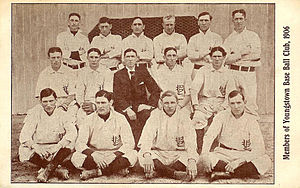
Youngstown Ohio Works (1906), with pitcher Roy Castleton seated in second row, second from left
The Youngstown Ohio Works baseball team was a minor league club that was known for winning the premier championship of the Ohio–Pennsylvania League in 1905, and for launching the professional career of pitcher Roy Castleton a year later. A training ground for several players and officials who later established careers in Major League Baseball, the team proved a formidable regional competitor and also won the 1906 league championship.
During its brief span of activity, the Ohio Works team faced challenges that reflected common difficulties within the Ohio–Pennsylvania League, including weak financial support for teams. Following a dispute over funding, the team's owners sold the club to outside investors, just a few months before the opening of the 1907 season. (Full article...) -
Image 5
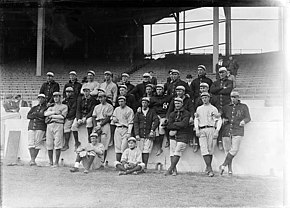
The 1913 squad, the first that went by the name "Yankees"
The history of the New York Yankees Major League Baseball (MLB) team spans more than a century. Frank J. Farrell and William Stephen Devery bought the rights to an American League (AL) club in New York City after the 1902 season. The team, which became known as the Yankees in 1913, rarely contended for the AL championship before the acquisition of outfielder Babe Ruth after the 1919 season. With Ruth in the lineup, the Yankees won their first AL title in 1921, followed by their first World Series championship in 1923. Ruth and first baseman Lou Gehrig were part of the team's Murderers' Row lineup, which led the Yankees to a then-AL record 110 wins and a Series championship in 1927 under Miller Huggins. They repeated as World Series winners in 1928, and their next title came under manager Joe McCarthy in 1932.
The Yankees won the World Series every year from 1936 to 1939 with a team that featured Gehrig and outfielder Joe DiMaggio, who recorded a record hitting streak during New York's 1941 championship season. New York set a major league record by winning five consecutive championships from 1949 to 1953, and appeared in the World Series nine times from 1955 to 1964. Mickey Mantle, Yogi Berra, and Whitey Ford were among the players fielded by the Yankees during the era. After the 1964 season, a lack of effective replacements for aging players caused the franchise to decline on the field, and the team became a money-loser for owners CBS while playing in an aging stadium. (Full article...) -
Image 6
George Herman "Babe" Ruth (February 6, 1895 – August 16, 1948) was an American professional baseball player whose career in Major League Baseball (MLB) spanned 22 seasons, from 1914 through 1935. Nicknamed "the Bambino" and "the Sultan of Swat", he began his MLB career as a star left-handed pitcher for the Boston Red Sox, but achieved his greatest fame as a slugging outfielder for the New York Yankees. Ruth is regarded as one of the greatest sports heroes in American culture and is considered by many to be the greatest baseball player of all time. In 1936, Ruth was elected to the Baseball Hall of Fame as one of its "first five" inaugural members.
At age seven, Ruth was sent to St. Mary's Industrial School for Boys, a reformatory where he was mentored by Brother Matthias Boutlier of the Xaverian Brothers, the school's disciplinarian and a capable baseball player. In 1914, Ruth was signed to play Minor League baseball for the Baltimore Orioles but was soon sold to the Red Sox. By 1916, he had built a reputation as an outstanding pitcher who sometimes hit long home runs, a feat unusual for any player in the dead-ball era. Although Ruth twice won 23 games in a season as a pitcher and was a member of three World Series championship teams with the Red Sox, he wanted to play every day and was allowed to convert to an outfielder. With regular playing time, he broke the MLB single-season home run record in 1919 with 29. (Full article...) -
Image 7
Jack Roosevelt Robinson (January 31, 1919 – October 24, 1972) was an American professional baseball player who became the first African-American to play in Major League Baseball (MLB) in the modern era. Robinson broke the color line when he started at first base for the Brooklyn Dodgers on April 15, 1947. The Dodgers signing Robinson heralded the end of racial segregation in professional baseball, which had relegated black players to the Negro leagues since the 1880s.
Born in Cairo, Georgia, Robinson was raised in Pasadena, California. A four-sport student athlete at Pasadena Junior College and the University of California, Los Angeles, he was better known for football than he was for baseball, becoming a star college player with the UCLA Bruins football team. Following his college career, Robinson was drafted for service during World War II but was court-martialed for refusing to sit at the back of a segregated Army bus, eventually being honorably discharged. Afterwards, he signed with the Kansas City Monarchs of the Negro leagues, where he caught the eye of Branch Rickey, general manager of the Brooklyn Dodgers, who thought he would be the perfect candidate for breaking the color line in MLB. (Full article...) -
Image 8
Stanley Anthony Coveleski (born Stanislaus Kowalewski, July 13, 1889 – March 20, 1984) was an American right-handed pitcher in Major League Baseball who played for four American League (AL) teams between 1912 and 1928, primarily the Cleveland Indians. The star of the Indians pitching staff, he won over 20 games each year from the war-shortened 1918 season through 1921, leading the AL in shutouts twice and in strikeouts and earned run average (ERA) once each during his nine years with the club. The star of the 1920 World Series, he led the Indians to their first title with three complete-game victories, including a 3–0 shutout in the Game 7 finale. Traded to the Washington Senators after the 1924 season, he helped that club to its second AL pennant in a row with 20 victories against only 5 losses, including a 13-game winning streak, while again leading the league in ERA.
Coveleski followed in the footsteps of his brother Harry as a major league pitcher. But after making his debut with the Philadelphia Athletics in 1912, he was sidetracked by three more seasons in the minor leagues before joining the Indians in 1916, and won only 13 major league games before turning 27. Coveleski specialized in throwing the spitball, where the pitcher alters the ball with a foreign substance such as chewing tobacco. It was legal when his career began but prohibited in 1920, with Coveleski being one of 17 pitchers permitted to continue throwing the pitch. In 450 career games, Coveleski pitched 3,082 innings and posted a record of 215–142, with 224 complete games, 38 shutouts, and a 2.89 ERA. He set Cleveland records of 172 wins, 2,502+1⁄3 innings and 305 starts, which were later broken by Mel Harder and Willis Hudlin. He was inducted into the Baseball Hall of Fame in 1969. (Full article...) -
Image 9
A picture of a Wii Sports disc
Wii Sports is a 2006 sports simulation video game developed and published by Nintendo for the Wii video game console. The game was released in North America along with the Wii on November 19, 2006, and in Japan, Australia, and Europe the following month. It was included as a pack-in game with the console in all territories except Japan, making it the first sports game included with the launch of a Nintendo system since Mario's Tennis for the Virtual Boy in 1995. The game was later released on its own as part of the Nintendo Selects collection of games.
Wii Sports is a collection of five sports simulations designed to demonstrate the motion-sensing capabilities of the Wii Remote. The five sports included are tennis, baseball, bowling, golf, and boxing. Players use the Wii Remote to mimic actions performed in real-life sports, such as swinging a tennis racket or rolling a bowling ball. The rules for each game are simplified to make them more accessible to new players. The game also features training and fitness modes that monitor players' progress in the sports. (Full article...) -
Image 10

Hershiser pitching for the Dodgers in 1993
During the 1988 Major League Baseball season, pitcher Orel Hershiser of the Los Angeles Dodgers set the MLB record for consecutive scoreless innings pitched. Over 59 consecutive innings, opposing hitters did not score a run against Hershiser. During the streak, he averted numerous high-risk scoring situations. The streak spanned from the sixth inning of an August 30 game against the Montreal Expos to the 10th inning of a September 28 game against the San Diego Padres. The previous record of 58+2⁄3 innings was set by former Dodger pitcher Don Drysdale in 1968; as the team's radio announcer, Drysdale called Hershiser's streak as he pursued the new record. Pundits have described the streak as among the greatest records in baseball history, with one pundit ranking it among the greatest individual feats in American sports.
During the streak, the Elias Sports Bureau changed its criteria for the official consecutive scoreless innings record for starting pitchers from including fractional innings in which one or two outs had been recorded to counting only complete scoreless innings. Since the streak was active at the end of the 1988 season, it could have spanned two separate seasons. However, Hershiser yielded a run in his first inning of work in the 1989 season against the Cincinnati Reds, thus ending the streak at 59 consecutive scoreless innings pitched. The streak includes only innings pitched in the regular season, excluding eight scoreless innings Hershiser pitched to start Game 1 of the 1988 National League Championship Series on October 4 (unofficially extending his streak to 67 combined innings). Although he completed the ninth inning in each start, the streak's final game lasted 16 innings, of which he pitched only the first 10. Thus, Hershiser did not match Drysdale's record of six consecutive complete game shutouts. Like Drysdale's streak, the penultimate game of Hershiser's streak was a Dodgers–Giants game that featured a controversial umpire's ruling that saved the streak. (Full article...) -
Image 11

WSNS-TV (channel 44) is a television station in Chicago, Illinois, United States, serving as the local outlet for the Spanish-language network Telemundo. It is owned and operated by NBCUniversal's Telemundo Station Group alongside NBC outlet WMAQ-TV (channel 5). The two stations share studios at the NBC Tower on North Columbus Drive in the city's Streeterville neighborhood and broadcast from the same transmitter atop the Willis Tower in the Chicago Loop.
WSNS-TV began broadcasting in 1970. Originally specializing in the automated display of news headlines, it evolved into Chicago's third full-fledged independent station, carrying movies, local sports, and other specialty programming. This continued until 1980, when WSNS became the Chicago-area station for ON TV, an over-the-air subscription television (STV) service owned by Oak Industries, which took a minority ownership stake in the station. While ON TV was successful in Chicago and the subscription system became the second-largest in the country by total subscribers, the rise of cable television precipitated the end of the business in 1985, with WSNS-TV as the last ON TV station standing. (Full article...) -
Image 12
Morgan Gardner Bulkeley (December 26, 1837 – November 6, 1922) was an American politician of the Republican Party, businessman, and insurance executive. In 1876, he served as the first president of baseball's National League and, because of that, was inducted into the National Baseball Hall of Fame in 1937, a choice that remains controversial, since his time as a baseball executive was short.
Bulkeley was born in East Haddam, Connecticut. His father was Judge Eliphalet Adams Bulkeley, a prominent local lawyer and businessman, who became the first president of the Aetna Life Insurance Company. The family moved to Hartford, where Morgan Bulkeley was educated, before he took a job in the city of Brooklyn, New York. He served briefly in the American Civil War, where he saw no combat. When his father died in 1872, he moved back to Hartford and became a bank president and a board member of Aetna, becoming its president in 1879, a post he held the rest of his life. (Full article...) -
Image 13

Lawrence Winchester Wetherby (January 2, 1908 – March 27, 1994) was an American politician who served as Lieutenant Governor and Governor of Kentucky. He was the first of only two governors in state history born in Jefferson County, despite the fact that Louisville (the county seat) is the state's most populous city. The second governor born in Jefferson County is the incumbent governor, Andy Beshear.
After graduating from the University of Louisville, Wetherby held several minor offices in the Jefferson County judicial system before being elected lieutenant governor in 1947. He was called Kentucky's first "working" lieutenant governor because Governor Earle C. Clements asked him to carry out duties beyond his constitutional responsibility to preside over the state Senate, such as preparing the state budget and attending the Southern Governors Conference. In 1950, Clements resigned to assume a seat in the U.S. Senate, elevating Wetherby to governor. Wetherby won immediate acclaim by calling a special legislative session to increase funding for education and government benefits from the state's budget surplus. In 1951, he won a four-year full term as governor, during which he continued and expanded many of Clements' programs, including increased road construction and industrial diversification. He endorsed the Supreme Court's 1954 desegregation order in the case of Brown v. Board of Education and appointed a biracial commission to oversee the successful integration of the state's schools. As chairman of the Southern Governors Conference in 1954 and 1955, he encouraged other southern governors to accept and implement desegregation. (Full article...) -
Image 14

KARE (channel 11) is a television station licensed to Minneapolis, Minnesota, United States, serving as the NBC affiliate for the Twin Cities area. Owned by Tegna Inc., the station maintains studios on Olson Memorial Highway (MN 55) in Golden Valley and a transmitter at the Telefarm site in Shoreview, Minnesota.
Channel 11 began broadcasting on September 1, 1953. It was originally shared by WMIN-TV in St. Paul and WTCN-TV in Minneapolis; the two stations shared an affiliation with ABC and alternated presenting local programs. In 1955, Consolidated Television and Radio bought both stations and merged them as WTCN-TV from the Minneapolis studios in the Calhoun Beach Hotel. The station presented several regionally and nationally notable children's shows in its early years as well as local cooking, news, and sports programs. Time Inc. purchased the station in 1957. Under its ownership, ABC switched its affiliation to KMSP-TV (channel 9), leaving channel 11 to become an independent station that broadcast games of the Minnesota Twins baseball team, movies, and syndicated programs. This continued under two successive owners: Chris-Craft Industries and Metromedia. By the late 1970s, WTCN was one of the nation's most financially successful independent stations. (Full article...) -
Image 15
John Joseph McGraw (April 7, 1873 – February 25, 1934) was an American Major League Baseball (MLB) player and manager who was for almost thirty years manager of the New York Giants. He was also the third baseman of the pennant-winning 1890s Baltimore Orioles teams, noted for their innovative, aggressive play.
McGraw was born into poverty in Truxton, New York. He found an escape from his hometown and a bad family situation through baseball, beginning a quick rise through the minor leagues that led him to the Orioles at the age of 18. Under the tutelage of manager Ned Hanlon, the Orioles of the 1890s won three National League (NL) pennants; McGraw was one of the stalwarts of the team alongside Wee Willie Keeler, Hughie Jennings, and Wilbert Robinson. The Orioles perfected the hit and run play and popularized the Baltimore chop; they also sought to win by intimidating the opposing team and the umpire. (Full article...)
General images - load new batch
-
Image 1Alexander Cartwright, father of modern baseball (from History of baseball)
-
Image 2A New York Yankees batter (Andruw Jones) and a Boston Red Sox catcher at Fenway Park (from Baseball)
-
Image 42013 World Baseball Classic championship match between the Dominican Republic and Puerto Rico, March 20, 2013 (from Baseball)
-
Image 5Baseball games sometimes end in a walk-off home run, with the batting team usually gathering at home plate to celebrate the scoring of the winning run(s). (from Baseball rules)
-
Image 6The typical motion of a right-handed pitcher (from Baseball rules)
-
Image 7The NL champion New York Giants baseball team, 1913. Fred Merkle, sixth in line, had committed a baserunning gaffe in a crucial 1908 game that became famous as Merkle's Boner. (from History of baseball)
-
Image 8The strike zone determines the result of most pitches, and varies in vertical length for each batter. (from Baseball)
-
Image 9A game from the Cantigas de Santa Maria, c. 1280, involving tossing a ball, hitting it with a stick and competing with others to catch it (from History of baseball)
-
Image 11A first baseman receives a pickoff throw, as the runner dives back to first base. (from Baseball)
-
Image 12Pesäpallo, a Finnish variation of baseball, was invented by Lauri "Tahko" Pihkala in the 1920s, and after that, it has changed with the times and grown in popularity. Picture of Pesäpallo match in 1958 in Jyväskylä, Finland. (from Baseball)
-
Image 13A runner sliding into home plate and scoring. (from Baseball)
-
Image 14Two players on the baseball team of Tokyo, Japan's Waseda University in 1921 (from Baseball)
-
Image 16A well-worn baseball (from Baseball)
-
Image 17Diagram of a baseball field Diamond may refer to the square area defined by the four bases or to the entire playing field. The dimensions given are for professional and professional-style games. Children often play on smaller fields. (from Baseball)
-
Image 18Rickey Henderson—the major leagues' all-time leader in runs and stolen bases—stealing third base in a 1988 game (from Baseball)
-
Image 19Pick-off attempt on runner (in red) at first base (from Baseball rules)
-
Image 20A pitcher handing off the ball after being taken out of the game during a mound meeting. (from Baseball)
-
Image 21Baserunners generally stand a short distance away from their base between pitches, preparing themselves to either go back or steal the next base. (from Baseball rules)
-
Image 22Japanese-Americans spectating a World War II-era game while in an internment camp. America's ties to immigrants and to Japan have been deeply shaped by a shared baseball heritage. (from History of baseball)
-
Image 23Pitchers are generally substituted during mound visits (team gatherings at the pitcher's mound). (from Baseball rules)
-
Image 24The standard fielding positions (from Baseball rules)
-
Image 25Jackie Robinson in 1945, with the era's Kansas City Royals, a barnstorming squad associated with the Negro American League's Kansas City Monarchs (from History of baseball)
-
Image 27The American Tobacco Company's line of baseball cards featured shortstop Honus Wagner of the Pittsburgh Pirates from 1909 to 1911. In 2007, the card shown here sold for $2.8 million. (from Baseball)
-
Image 28Jackie Robinson in 1945, with the era's Kansas City Royals, a barnstorming squad associated with the Negro American League's Kansas City Monarchs (from Baseball)
-
Image 29Cover of Official Base Ball Rules, 1921 edition, used by the American League and National League (from Baseball rules)
-
Image 31The strike zone, which determines the outcome of most pitches, varies in vertical length depending on the batter's typical height while swinging. (from Baseball rules)
-
Image 32A batter follows through after swinging at a pitched ball. (from Baseball rules)
-
Image 33In May 2010, the Philadelphia Phillies' Roy Halladay pitched the 20th major league perfect game. That October, he pitched only the second no-hitter in MLB postseason history. (from History of baseball)
-
Image 341906 World Series, infielders playing "in" for the expected bunt and the possible play at the plate with the bases loaded (from Baseball rules)
-
Image 35Sadaharu Oh managing the Japan national team in the 2006 World Baseball Classic. Playing for the Central League's Yomiuri Giants (1959–80), Oh set the professional world record for home runs with 868. (from History of baseball)
-
Image 36Defensive positions on a baseball field, with abbreviations and scorekeeper's position numbers (not uniform numbers) (from Baseball)
-
Image 39By the 1860s Civil War, baseball (bottom) had overtaken its fellow bat-and-ball sport cricket (top) in popularity within the United States. (from History of baseball)
-
Image 41Fenway Park, home of the Boston Red Sox. The Green Monster is visible beyond the playing field on the left. (from Baseball)
-
Image 42An Afghan girl playing baseball in August 2002 (from Baseball)
-
Image 43Cy Young—the holder of many major league career marks, including wins and innings pitched, as well as losses—in 1908. MLB's annual awards for the best pitcher in each league are named for Young. (from Baseball)
-
Image 44Sadaharu Oh managing the Japan national team in the 2006 World Baseball Classic. Playing for the Central League's Yomiuri Giants (1959–80), Oh set the professional world record for home runs. (from Baseball)
 Good articles - load new batch
Good articles - load new batch
-
Image 1
Sonia Maria Sotomayor (/ˈsoʊnjə ˌsoʊtoʊmaɪˈjɔːr/ ⓘ, Spanish: [ˈsonja sotomaˈʝoɾ]; born June 25, 1954) is an American lawyer and jurist who serves as an associate justice of the Supreme Court of the United States. She was nominated by President Barack Obama on May 26, 2009, and has served since August 8, 2009. She is the third woman, the first woman of color, the first Hispanic, and the first Latina to serve on the Supreme Court.
Sotomayor was born in the Bronx, New York City, to Puerto Rican-born parents. Her father died when she was nine, and she was subsequently raised by her mother. Sotomayor graduated summa cum laude from Princeton University in 1976 and received her Juris Doctor from Yale Law School in 1979, where she was an editor of the Yale Law Journal. Sotomayor worked as an assistant district attorney in New York for four and a half years before entering private practice in 1984. She played an active role on the boards of directors for the Puerto Rican Legal Defense and Education Fund, the State of New York Mortgage Agency, and the New York City Campaign Finance Board. (Full article...) -
Image 2Arthur Lee Guetterman (born November 22, 1958), nicknamed "Goot," is an American former professional baseball pitcher who played from 1984 to 1996 for the Seattle Mariners, New York Yankees, New York Mets, and St. Louis Cardinals of Major League Baseball (MLB). A southpaw used primarily in the major leagues as a relief pitcher, he stood 6 feet 8 inches (2.03 m) tall. He led the Yankees in wins in 1990 without starting a game.
Guetterman attended Liberty University, where he set several school records on the baseball team. Drafted by the Mariners in the fourth round of the 1981 Major League Baseball (MLB) Draft, he made his major league debut in 1984, though he would not return to the major leagues until 1986. After having the highest earned run average (ERA) of any American League (AL) pitcher with at least 75 innings pitched in 1986, he won 11 games as a starter in 1987, posting an 8–1 record at one point before getting moved to the bullpen due to a loss of control of his pitches. He was traded to the Yankees after the season, and after spending much of 1988 in the minor leagues, he emerged as a part-time closer for the Yankees in 1989, while Dave Righetti was struggling. He had 13 saves in 1989, then just two the following year, though he would lead the Yankees in wins. In 1991, Guetterman became unhappy with his playing time and requested a trade, which he got in 1992, when he was part of the only Yankees-Mets trade between 1987 and 2001. (Full article...) -
Image 3
David Richard Freese (born April 28, 1983) is an American former professional baseball third baseman. He began his Major League Baseball (MLB) career with the St. Louis Cardinals in 2009, where, two seasons later, he was a key player during the 2011 postseason, batting .545 with 12 hits in the 2011 National League Championship Series (NLCS). At the time, he also set an MLB postseason record of 21 runs batted in (RBIs), which earned him the NLCS MVP Award and World Series MVP Award. In addition, Freese won the Babe Ruth Award, naming him the MVP of the 2011 MLB postseason. He also played for the Los Angeles Angels, Pittsburgh Pirates, and Los Angeles Dodgers.
A star high school player, Freese declined a college baseball scholarship from the University of Missouri. Needing a break from baseball, he sat out his freshman year of college before feeling a renewed urge to play the game. He transferred to St. Louis Community College–Meramec, a junior college, where he played for one season before transferring to the University of South Alabama. The San Diego Padres selected Freese in the ninth round of the 2006 MLB draft. (Full article...) -
Image 4

William Mitchell Steele (October 5, 1885 – October 19, 1949) was an American pitcher in Major League Baseball (MLB). He pitched from 1910 to 1914 with the St. Louis Cardinals and Brooklyn Robins. Nicknamed "Big Bill", at 5 feet 11 inches (1.80 m), he was one of the larger players of his era. His main pitch was a spitball.
Steele grew up in Milford, Pennsylvania. He began pitching at the professional level in 1909, and after winning 25 games for the Altoona Rams in 1910, he was signed by the Cardinals. Steele appeared in nine games with the team that year, then pitched a career-high 287+1⁄3 innings in 1911. He led the National League (NL) with 19 losses while posting a 3.73 earned run average (ERA). In 1912, Steele posted the worst ERA (4.69) among pitchers with enough innings to qualify for the MLB ERA title. He claimed in 1913 that he had purposefully not been trying as hard as he could have in 1912, and this impaired his relationship with the front office. Bothered by rheumatism the next couple of seasons, Steele found himself used mainly as a mopup reliever by 1914. Sold to the Robins later that year, he finished his MLB career with eight appearances in a Brooklyn uniform. Steele then played minor league baseball for a couple more seasons. A few years after he retired, he and his family moved to the St. Louis area, where he worked as a mechanic for Swift and Company and later as a maintenance man at an A&P warehouse. He was killed on October 19, 1949, when a streetcar ran into him. (Full article...) -
Image 5
Dennis Lawrence "Dan" McGann (July 15, 1871 – December 13, 1910) was an American professional baseball first baseman and second baseman. He played in Major League Baseball (MLB) from 1896 to 1910, and won the World Series in 1905 with the New York Giants.
After beginning his professional career in minor league baseball in 1895, McGann played in MLB for the Boston Beaneaters (1896), Baltimore Orioles (1898), Brooklyn Superbas (1899), Washington Senators (1899), and St. Louis Cardinals (1900–1901) of the National League (NL) before jumping to the rival American League to play for the Baltimore Orioles in 1902. He returned to the NL, playing for the New York Giants (1902–1907) and Boston Doves (1908). In 1909–10, he played for the Milwaukee Brewers in the American Association. (Full article...) -
Image 6Ralph Joseph "Putsy" Caballero (November 5, 1927 – December 8, 2016) was an American professional baseball infielder who played in Major League Baseball (MLB) in parts of eight seasons, all for the Philadelphia Phillies, during the Whiz Kids era. He holds the record as the youngest person in MLB history to appear at third base.After graduating from Jesuit High School in New Orleans at age 16, the Phillies signed Caballero to a contract worth $10,000. Following a few short stints at the major league level and playing parts of three seasons in the minor leagues, Caballero was named the Phillies starter at third base in 1948. In his only season as an everyday player, Caballero batted .245 in 380 plate appearances at age 20. After another stint in the minors in 1949, he was a backup infielder, pinch hitter, and pinch runner for the 1950 Phillies, and continued in that role through 1952. Following three more years in the minors, Caballero retired from baseball after the 1955 season. After his baseball career ended, Caballero worked as an exterminator. His Louisiana home was destroyed in 2005 during Hurricane Katrina, whereupon he then lived in Lakeview, New Orleans. (Full article...)
-
Image 7Jesse Roy Levan (July 15, 1926 – November 30, 1998) was an American professional baseball player. In a 14-season pro career, he appeared in Major League Baseball in 1947 with the Philadelphia Phillies of the National League and in 1954 and 1955 with the American League's Washington Senators. He was officially listed as standing 6 feet (180 cm) and weighing 172 pounds (78 kg). In 25 career major league games, Levan had a .286 batting average with a home run and five runs batted in (RBI).
Levan originally signed with the Phillies organization in 1944, then served in World War II after one season. He returned in 1947 and spent two games on the major league roster before returning to the minor leagues, where he won multiple minor league batting titles. He bounced around in various minor league organizations until 1954, when the Washington Senators picked him up. Levan spent the next two seasons with Washington before spending four years with the Chattanooga Lookouts. While in Chattanooga, Levan became the last person banned by baseball's governing organizations for conspiring to fix games, which ended his professional career. (Full article...) -
Image 8
Cody Joseph Ross (born December 23, 1980), nicknamed "Toy Cannon" and "Ross the Boss," is an American former professional baseball outfielder. He played in Major League Baseball (MLB) for 12 seasons; with the Detroit Tigers (2003), Los Angeles Dodgers (2005–2006), Cincinnati Reds (2006), Florida Marlins (2006–2010), San Francisco Giants (2010–2011), Boston Red Sox (2012), Arizona Diamondbacks (2013–2014) and Oakland Athletics (2015). Ross won a World Series with the San Francisco Giants in 2010. He is one of the few Major League players to bat right-handed and throw left-handed.
Following high school, Ross embarked on his professional career, getting selected by the Detroit Tigers in the fourth round of the 1999 Major League Baseball draft. He reached the Major Leagues in 2003, but suffered a torn ACL which caused him to miss most of September. He was traded to the Los Angeles Dodgers following spring training in 2004, appearing in a handful of games with them in 2005. In 2006, he played for the Los Angeles Dodgers, the Cincinnati Reds, and the Florida Marlins. It was in Florida that he finally established himself, as he played with the Marlins through 2010. He was used mainly as a reserve outfielder in 2006 and 2007, but during the 2008 season he took over a starting role. He would be a starting outfielder for the rest of his Marlins career, playing center field or right field. In 2009, he hit a career-high 24 home runs and won the Marlins' Charlie Hough Good Guy award. (Full article...) -
Image 9Dock Phillip Ellis Jr. (March 11, 1945 – December 19, 2008) was an American professional baseball player. He played in Major League Baseball as a right-handed pitcher from 1968 through 1979, most notably as a member of the Pittsburgh Pirates teams that won five National League Eastern Division titles in six years between 1970 and 1975 and won the World Series in 1971. Ellis also played for the New York Yankees, Oakland Athletics, Texas Rangers and New York Mets. In his MLB career, Ellis accumulated a 138–119 (.537) record, a 3.46 earned run average, and 1,136 strikeouts.
Ellis threw a no-hitter on June 12, 1970, and later stated that he accomplished the feat under the influence of LSD. Ellis was the starting pitcher for the National League in the All-Star Game in 1971. Joining the Yankees in 1976, he helped lead the team to the American League pennant, and was named the Sporting News Comeback Player of the Year Award. (Full article...) -
Image 10
Clayton Edward Kershaw (born March 19, 1988) is an American professional baseball pitcher who is a free agent. He has played in Major League Baseball (MLB) for the Los Angeles Dodgers. A left-handed starting pitcher, Kershaw has spent his entire MLB career with the Dodgers since debuting in 2008. He is a ten-time All-Star, three-time National League (NL) Cy Young Award winner, the 2014 NL Most Valuable Player, and a World Series champion in 2020. He is widely regarded as one of the greatest pitchers in baseball history.
Kershaw was drafted by the Dodgers in the first round of the 2006 MLB draft and was the seventh overall pick. He worked his way through the Dodgers' farm system and reached the majors at age 20 after one season. In 2011, he won the pitching Triple Crown and the NL Cy Young Award, becoming the youngest pitcher to accomplish either of these feats since Dwight Gooden in 1985. Kershaw pitched a no-hitter on June 18, 2014, becoming the 22nd Dodger to do so. (Full article...) -
Image 11Donald Paul Black (July 20, 1916 or 1917 – April 21, 1959) was an American right-handed pitcher in Major League Baseball who played for six seasons in the American League with the Philadelphia Athletics and Cleveland Indians. In 154 career games, Black pitched 797 innings and posted a win–loss record of 34–55, with 37 complete games, four shutouts, and a 4.35 earned run average (ERA).
Born in Salix, Iowa, he played minor league baseball in Fairbury, Nebraska, and Petersburg, Virginia, before signing with the Philadelphia Athletics. He played with them for three seasons before being released. Black signed with the Cleveland Indians at the end of 1945, and after a season with them joined Alcoholics Anonymous. After completing the program, during the off season, he then played two more seasons with Cleveland, pitching a no-hitter on July 10, 1947. On September 13, 1948, Black suffered a cerebral hemorrhage on the field, which marked the end of his professional career. After a comeback attempt, Black went on to become a sports announcer and salesman. He died in 1959. (Full article...) -
Image 12

Charles "Boss" Schmidt (September 12, 1880 – November 14, 1932) was an American baseball catcher for the Detroit Tigers of Major League Baseball (MLB)
A native of Arkansas, Schmidt played professional baseball from 1901 to 1926, including six seasons in MLB with Detroit from 1906 to 1911. He was the starting catcher on the Detroit teams that won three consecutive American League pennants from 1907 to 1909. He also led the American League in errors by a catcher in each of those seasons. Schmidt had a reputation for toughness enhanced by his grotesque-looking hands, the result of work as a coal miner and prizefighter. (Full article...) -
Image 13"Homer at the Bat" is the seventeenth episode of the third season of the American animated television series The Simpsons. It originally aired on Fox in the United States on February 20, 1992. The episode follows the Springfield Nuclear Power Plant softball team, led by Homer, having a winning season and making the championship game. Mr. Burns makes a large bet that the team will win and brings in nine ringers from the "big leagues" to ensure his success.
The episode was written by John Swartzwelder and directed by Jim Reardon. Roger Clemens, Wade Boggs, Ken Griffey Jr., Steve Sax, Ozzie Smith, Jose Canseco, Don Mattingly, Darryl Strawberry, and Mike Scioscia all guest starred as themselves, playing the ringers hired by Mr. Burns. Terry Cashman sang "Talkin' Softball", a modified version of his song "Talkin' Baseball", over the end credits. "Homer at the Bat" underwent a lengthy production, as the guest stars were recorded over several months in accordance with their availability. Most of the players were accommodating except for Canseco, who demanded that his part be rewritten. (Full article...) -
Image 14
Robert Neil Harvey (born 8 October 1928) is an Australian former cricketer who was a member of the Australian cricket team between 1948 and 1963, playing in 79 Test matches. He was the vice-captain of the team from 1957 until his retirement. An attacking left-handed batsman, sharp fielder and occasional off-spin bowler, Harvey was the senior batsman in the Australian team for much of the 1950s and was regarded by Wisden as the finest fielder of his era. Upon his retirement, Harvey was the second-most prolific Test run-scorer and century-maker for Australia.
One of six cricketing brothers, four of whom represented Victoria, Harvey followed his elder brother Merv into Test cricket and made his debut in January 1948, aged 19 and three months. In his second match, he became the youngest Australian to score a Test century, a record that still stands. Harvey was the youngest member of the 1948 Invincibles of Don Bradman to tour England, regarded as one of the finest teams in history. After initially struggling in English conditions, he made a century on his Ashes debut. Harvey started his career strongly, with six centuries in his first thirteen Test innings at an average over 100, including four in 1949–50 against South Africa, including a match-winning 151 not out on a sticky wicket. As Bradman's team broke up in the 1950s due to retirements, Harvey became Australia's senior batsman, and was named as one of the Wisden Cricketers of the Year in 1954, in recognition of his feat in scoring more than 2,000 runs during the 1953 tour of England. (Full article...) -
Image 15
Logan Gaffney Drake (December 26, 1899 – June 1, 1940) was an American professional baseball pitcher, a right-hander who played in Major League Baseball (MLB) from 1922 to 1924 for the Cleveland Indians. In 10 career games, Drake pitched 182⁄3 innings and posted a win–loss record of 0–1 with a 7.71 earned run average (ERA).
Born in Spartanburg, South Carolina, Drake began his professional career in 1919. He spent the next four seasons in the minor leagues, and was signed by the Cleveland Indians in late 1922. He played for the Indians at the end of the 1922 and 1923 seasons as well as the 1924 season until his release. He spent the rest of 1924 with the Wichita Falls Spudders until an injury caused him to lose his index finger. Despite the injury, he continued to play professional baseball until 1928. He then retired to South Carolina, operating a sandwich business until his death in 1940. (Full article...)
Did you know (auto-generated) - load new batch

- ... that Jenny Cavnar is the first female primary play-by-play announcer in Major League Baseball history?
- ... that Gil Kim played professional baseball in the Netherlands, China, Australia, Spain, and Venezuela, scouted in Mexico and the Dominican Republic, and coaches in Canada?
- ... that before Sean Jackson won three Ivy League basketball championships, he won high school state championships in both baseball and basketball?
- ... that Julie Croteau is credited as being the first woman to play National Collegiate Athletic Association men's college baseball?
- ... that Zack Kelly received a $500 signing bonus, lost money in his first professional seasons, and was released by two organizations before he made his Major League Baseball debut?
- ... that Chuck Eisenmann went from professionally pitching in baseball to owning and training the dogs that starred on the Canadian television series The Littlest Hobo?
- ... that Cy Block and Ross Horning testified before the United States Congress about how the reserve clause limited their careers in professional baseball?
- ... that the 2024 inductees to the Delaware Sports Museum and Hall of Fame include a man with Down syndrome who has lifted 425 pounds (193 kg), an "average gymnast" turned Olympics judge, a "preeminent sportswriter", the state's "greatest high hurdler", the "inventor" of the modern sports mascot, a record-setting 10-year-old, a champion gymnast, an Olympic field hockey player, and a pro baseball player in five countries?
Quotes
| Fans, for the past two weeks you have been reading about a bad break I got. Yet today, I consider myself the luckiest man on the face of the earth. I have been in ballparks for 17 years, and I have never received anything but kindness and encouragement from you fans. Look at these grand men. Which of you wouldn't consider it the highlight of his career just to associate with them for even one day?
— Lou Gehrig, speech made on Lou Gehrig Appreciation Day at Yankee at Yankee Stadium (July 4, 1939)
|
 Featured lists - load new batch
Featured lists - load new batch
-
Image 1

Félix Hernández, the 2007 and 2009-2018 Opening Day starter
The Seattle Mariners are a Major League Baseball (MLB) franchise based in Seattle, Washington. They play in the American League West division. The first game of the new baseball season for a team is played on Opening Day, and being named the Opening Day starter is an honor, which is often given to the player who is expected to lead the pitching staff that season, though there are various strategic reasons why a team's best pitcher might not start on Opening Day. The Mariners have used 15 different Opening Day starting pitchers in their 41 seasons. The 15 starters have a combined Opening Day record of 15 wins, 13 losses (15–13) and 13 no decisions. No decisions are only awarded to the starting pitcher if the game is won or lost after the starting pitcher has left the game.
Félix Hernández has the Mariners' record for most Opening Day starts with eleven, recording a record of 7–2. Randy Johnson has the most starts in the former home ballpark of the Mariners, the Kingdome, compiling an Opening Day record of 2–0 in 6 starts. Jamie Moyer has the most starts in Safeco Field, the Mariners' current home ballpark, and has an Opening Day record of 1–2. Mark Langston has the worst winning percentage as the Opening Day starting pitcher with a record of 0–3, all of which were pitched on the road. (Full article...) -
Image 2

Clayton Kershaw holds the Dodgers' record for most Opening Day starts with nine (2011–2018 & 2021).
The Los Angeles Dodgers are a Major League Baseball (MLB) franchise based in Los Angeles. They play in the National League West division. The first game of the new baseball season for a team is played on Opening Day, and being named the Opening Day starter is an honor, which is often given to the player who is expected to lead the pitching staff that season, though there are various strategic reasons why a team's best pitcher might not start on Opening Day. The Dodgers have used 26 different Opening Day starting pitchers in their 67 seasons in Los Angeles. The 26 starters have a combined Opening Day record of 29 wins, 27 losses and 10 no decisions.
The Dodgers started playing in Los Angeles in 1958, after moving from Brooklyn. The first Opening Day game for the Dodgers in Los Angeles was played in San Francisco against the San Francisco Giants on April 15, 1958. California native Don Drysdale was the Dodgers' Opening Day starting pitcher that day, in a game the Dodgers lost 8–0. Dodgers starting pitchers won both of their Opening Day starts in their first home ballpark in Los Angeles, Los Angeles Memorial Coliseum. (Full article...) -
Image 3The Dick Howser Trophy is bestowed annually to the national college baseball player of the year. The award is named after former collegiate and Major League Baseball (MLB) player and manager Dick Howser, who died as the result of brain cancer on June 17, 1987, at the age of 51. In that same year, the award was established by friends of Howser and presented to Mike Fiore, the inaugural winner. It is considered to be the Heisman Trophy of college baseball.
Six winners of the Dick Howser Trophy are members of the National College Baseball Hall of Fame. Five winners—Kris Benson, David Price, Stephen Strasburg, Adley Rutschman, and Paul Skenes—went on to become the first overall MLB draft pick. Jason Jennings, Buster Posey, and Kris Bryant went on to win the Rookie of the Year Award several years after winning the Dick Howser Trophy. Jered Weaver is the only award winner to pitch a no-hitter, while Mark Teixeira holds the record for most games with home runs from both sides of the plate. Furthermore, seventeen players won the Golden Spikes Award alongside the Dick Howser Trophy. Brooks Kieschnick is the only player to win the trophy more than once. (Full article...) -
Image 4The 1958 Babe Ruth Award, won by Elston Howard
The Babe Ruth Award is given annually to the Major League Baseball (MLB) player with the best performance in the postseason. The award, created in honor of Babe Ruth, was first awarded in 1949 to New York Yankee pitcher, Joe Page, the MVP of the World Series, one year after Ruth's death. The award was created by the New York City chapter of the Baseball Writers' Association of America (BBWAA). It continued to be awarded exclusively for performances in the World Series until 2007, when the New York chapter of the BBWAA changed the award to cover the entire postseason. Though it is older than the World Series Most Valuable Player Award, which was not created until 1955 (as the "SPORT Magazine Award"), the Babe Ruth Award is considered less prestigious, because it is not sanctioned by MLB and is awarded several weeks after the World Series.
MLB expanded its postseason to include the League Championship Series (LCS) in 1969, the League Division Series (LDS) in 1995, and the Wild Card round in 2012. The Wild Card Series is a best-of-three playoff format, the LDS follows a best-of-five playoff format, and the LCS and World Series follow a best-of-seven playoff format. In 2020, the Los Angeles Dodgers, won the 2020 World Series, but Randy Arozarena of the Tampa Bay Rays was named winner of the Babe Ruth Award. (Full article...) -
Image 5Roberto Alomar's 1994 Gold Glove Award
The Rawlings Gold Glove Award, usually referred to as simply the Gold Glove, is the award given annually to the Major League Baseball (MLB) players judged to have exhibited superior individual fielding performances at each fielding position in both the National League (NL) and the American League (AL). The Gold Glove is widely considered one of the most prestigious defensive awards in baseball.
Winners for position awards are determined from voting by the managers and coaches in each league, who are not permitted to vote for their own players. Additionally, a sabermetric component provided by the Society for American Baseball Research (SABR) accounts for about 25 percent of the vote. For the utility player awards, the sabermetric component and other defensive statistics are exclusively used to select the winners, without any voting by coaches. (Full article...) -
Image 6
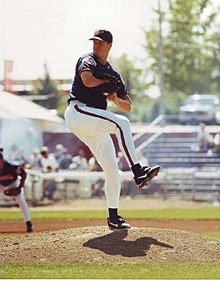
Jim Abbott (1988), born without a right hand, won the 1987 Golden Spikes Award, the 1992 Tony Conigliaro Award, and the 1995 Hutch Award.
The Los Angeles Angels are a Major League Baseball (MLB) franchise based in Anaheim, California. They play in the American League (AL) West division. Since the institution of Major League Baseball's Rule 4 Draft in 1965, the Angels have selected 62 players in the first round. Officially known as the "First-Year Player Draft", the Rule 4 Draft is Major League Baseball's primary mechanism for assigning amateur players from high schools, colleges, and other amateur clubs to its teams. The draft order is determined based on the previous season's standings, with the team possessing the worst record receiving the first pick. In addition, teams which lost free agents in the previous off-season may be awarded compensatory or supplementary picks.
Of the 66 players drafted by the Angels, 29 have been pitchers, the most of any position; 18 of these were right-handed, while 11 were left-handed. Fourteen outfielders, eight shortstops, four third basemen, and four first basemen were also taken. No second basemen have been selected. Thirteen of the players came from high schools or universities in the state of California, while Florida follows with six players. Four players have been selected from both Illinois and Georgia. All players selected have been from the United States. The franchise has made five selections in the same draft three times, in 1986, 2009, and 2010. (Full article...) -
Image 7
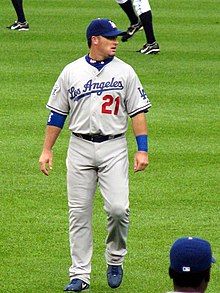
Mark Sweeney, the career pinch hit RBI recordholder, was named to the All-America Team in 1991 by both the American Baseball Coaches Association and Collegiate Baseball.
An All-American team is an honorary sports team composed of the best amateur players of a specific season for each position—who in turn are given the honorific "All-America" and typically referred to as "All-American athletes", or simply "All-Americans". Although the honorees generally do not compete as a unit, the term is used in U.S. team sports to refer to players who are selected by members of the national media. Walter Camp selected the first All-America team in the early days of American football in 1889. In 1950, the American Baseball Coaches Association (ABCA) selected its first All-American baseball team. It has since chosen All-American teams and a player of the year for each division (National Collegiate Athletic Association (NCAA) Division I, Division II, Division III, National Association of Intercollegiate Athletics, junior college and high school). In 1991, Collegiate Baseball began selecting college All-American, Freshman All-American, and High School All-American teams. Baseball America has selected – since 1981 – pre-season and post-season All-American teams and College Player of the Year honorees.
Various organizations selected All-American lists of the best players for the 1991 NCAA Division I college baseball season. The ABCA, the magazine Baseball America, and Collegiate Baseball were the NCAA-sanctioned selectors. This list only includes players selected to the post-season All-American first team for each selector. However, many All-American selections choose second, third, etc. teams from the remaining eligible candidates. (Full article...) -
Image 8

1891 Athletics manager Bill Sharsig
The Philadelphia Athletics were a professional baseball team that existed for two seasons from 1890 to 1891. Known alternatively as the Philadelphia Quakers, and sometimes informally as "Buffinton's Beauties", they played their first season in the newly created Players' League (PL) of 1890, and were managed by Jim Fogarty and Charlie Buffinton. After the demise of the PL following the 1890 season, the team joined the American Association (AA) for the 1891 season, and were managed by Bill Sharsig and George Wood. For each season, the franchise used Forepaugh Park as their home field.
Despite the existence of established major league representation in Philadelphia, the Phillies of the National League (NL) and the Athletics of the AA, the new PL franchise was able to sign veteran players, including Buffinton, Billy Shindle, George Wood, and Ben Sanders. The Quakers finished the season with a 68–63 win–loss record, with one tie, placing them fifth among the eight PL teams. (Full article...) -
Image 9The San Diego Padres are an American professional baseball team based in San Diego. The Padres compete in Major League Baseball (MLB) as a member club of the National League (NL) West Division. Since the institution of MLB's Rule 4 Draft, the Padres have selected 73 players in the first round. Officially known as the "First-Year Player Draft", the Rule 4 Draft is MLB's primary mechanism for assigning players from high schools, colleges, and other amateur clubs to its franchises. The draft order is determined based on the previous season's standings, with the team possessing the worst record receiving the first pick. In addition, teams which lost free agents in the previous off-season may be awarded compensatory or supplementary picks. The First-Year Player Draft is unrelated to the 1968 expansion draft in which the Padres initially filled their roster.
Of the 73 players picked in the first round by San Diego, 32 have been pitchers, the most of any position; 20 of these were right-handed, while 12 were left-handed. Fourteen outfielders were selected, while ten shortstops, seven catchers, five third basemen, and four first basemen were taken as well. The team has also drafted one player at second base. Eleven of the players came from high schools or universities in the state of California, and Florida and Georgia follow with ten and six players, respectively. (Full article...) -
Image 10

Ryne Sandberg has the most wins among National League second basemen with seven Silver Slugger Awards.
The Silver Slugger Award is awarded annually to the best offensive player at each position in both the American League (AL) and the National League (NL), as determined by the coaches and managers of Major League Baseball (MLB). These voters consider several offensive categories in selecting the winners, including batting average, slugging percentage, and on-base percentage, in addition to "coaches' and managers' general impressions of a player's overall offensive value". Managers and coaches are not permitted to vote for players on their own team. The Silver Slugger was first awarded in 1980 and is given by Hillerich & Bradsby, the manufacturer of Louisville Slugger bats. The award is a bat-shaped trophy, 3 feet (91 cm) tall, engraved with the names of each of the winners from the league and plated with sterling silver.
Among second basemen, Ryne Sandberg, who played 15 seasons with the Chicago Cubs in his 16-year career, is tied for the most Silver Sluggers all-time with seven wins, and is first among all National League second basemen, including five consecutive from 1988 to 1992. Three other National League players have won the award four times. Jeff Kent (2000–2002, 2005) won three consecutive awards with the San Francisco Giants, before adding a fourth with the Los Angeles Dodgers; Craig Biggio, who played his entire career with the Houston Astros, won the award four times as a second baseman (1994–1995, 1997–1998) after winning another as a catcher. Chase Utley followed Kent's last win by capturing four consecutive awards (2006–2009). (Full article...) -
Image 11Jackie Robinson, the inaugural winner in 1947 and eventual namesake of the award
In Major League Baseball, the Rookie of the Year Award is given annually to two outstanding rookie players, one each for the American League (AL) and National League (NL), as voted on by the Baseball Writers' Association of America (BBWAA). The award was established in 1940 by the Chicago chapter of the BBWAA, which selected an annual winner from 1940 through 1946. The award became national in 1947; Jackie Robinson, the Brooklyn Dodgers' second baseman, won the inaugural award. One award was presented for all of MLB in 1947 and 1948; since 1949, the honor has been given to one player each in the NL and AL. Originally, the award was known as the J. Louis Comiskey Memorial Award, named after the Chicago White Sox owner of the 1930s. The award was renamed the Jackie Robinson Award in July 1987, 40 years after Robinson broke the baseball color line.
Nineteen players have been elected to the National Baseball Hall of Fame—Robinson, seven AL players, and eleven others from the NL. The award has been shared twice: once by Butch Metzger and Pat Zachry of the NL in 1976; and once by John Castino and Alfredo Griffin of the AL in 1979. Members of the Brooklyn and Los Angeles Dodgers have won the most awards of any franchise (with 18). Fred Lynn and Ichiro Suzuki are the only two players who have been named Rookie of the Year and Most Valuable Player in the same year, and Fernando Valenzuela is the only player to have won Rookie of the Year and the Cy Young Award in the same year. Sam Jethroe is the oldest player to have won the award, at age 32, 33 days older than 2000 winner Kazuhiro Sasaki (also 32). Luis Gil of the New York Yankees and Paul Skenes of the Pittsburgh Pirates are the most recent winners. (Full article...) -
Image 12
An All-American team is an honorary sports team composed of the best amateur players of a specific season for each position—who in turn are given the honorific "All-America" and typically referred to as "All-American athletes", or simply "All-Americans". Although the honorees generally do not compete as a unit, the term is used in U.S. team sports to refer to players who are selected by members of the national media. Walter Camp selected the first All-America team in the early days of American football in 1889. In 1950, the American Baseball Coaches Association (ABCA) selected its first All-American baseball team. It has since chosen All-American teams and a player of the year for each division (National Collegiate Athletic Association (NCAA) Division I, Division II, Division III, National Association of Intercollegiate Athletics, junior college and high school). Collegiate Baseball selects All-American, Freshman All-American and High School All-American teams. Baseball America magazine selects pre-season and post-season All-American teams and College Player of the Year honorees.
Various organizations selected All-American lists of the best players for the 1993 NCAA Division I college baseball season. The ABCA, the magazine Baseball America, and Collegiate Baseball were the NCAA-sanctioned selectors. This list only includes players selected to the post-season All-American first team for each selector. However, many All-American selections choose second, third, etc. teams from the remaining eligible candidates. (Full article...) -
Image 13

Babe Ruth was the first player to reach 500 home runs and set a career home run mark of 714 that stood until 1974.
In Major League Baseball (MLB), the 500 home run club is a group of batters who have hit 500 or more regular-season home runs in their careers. There are twenty-eight players who are members of the 500 home run club. Seven 500 home run club members—Hank Aaron, Willie Mays, Eddie Murray, Rafael Palmeiro, Albert Pujols, Alex Rodriguez and Miguel Cabrera—are also members of the 3,000 hit club.
In the past, membership in the 500 home run club was a guarantee of eventual entry into the Baseball Hall of Fame, although some believe the milestone has become less meaningful in recent years and many members have not been enshrined in Cooperstown. (Full article...) -
Image 14

Mark Teixeira (2001) played 162 games for the Rangers in back-to-back seasons and finished second in the MVP voting in 2009.
The Texas Rangers are a Major League Baseball (MLB) franchise based in the Dallas–Fort Worth metropolitan area. They play in the American League West division. Before 1972 (and for the first seven years of the draft), they were known as the Washington Senators and based in Washington, D.C. Since the institution of MLB's Rule 4 Draft, the Rangers franchise has selected 68 players in the first round. Officially known as the "First-Year Player Draft", the Rule 4 Draft is MLB's primary mechanism for assigning amateur baseball players from high schools, colleges, and other amateur baseball clubs to its teams. The draft order is determined based on the previous season's standings, with the team possessing the worst record receiving the first pick. In addition, teams which lost free agents in the previous off-season may be awarded compensatory or supplementary picks.
Of the 71 players picked in the first round by Washington or Texas, 37 have been pitchers, the most of any position; 27 of these were right-handed, while 10 were left-handed. Twelve outfielders, nine third basemen, six shortstops, four catchers, two first basemen, and one second baseman were also taken. Fourteen of the players came from high schools or colleges in the state of Texas, and California follows with ten players. The Rangers have drafted one player, Tanner Scheppers in 2009, who was playing in the American Association of Independent Professional Baseball at the time of the draft. Scheppers was originally drafted by the Baltimore Orioles in the 29th round of the 2005 MLB Draft, and by the Pittsburgh Pirates in the second round of the 2008 MLB Draft. (Full article...) -
Image 15

Bill Virdon is the all-time winningest manager in Astro history; he won 544 games while leading the Astros to their first postseason berth in 1980 and two division titles.
The Houston Astros are a professional baseball franchise based in Houston, Texas. They are a member of the American League West Division in Major League Baseball. The team joined MLB in 1962 as an expansion team named the Houston Colt .45s and changed their name to the Houston Astros in 1965. The team won their first NL Championship in 2005. Having first played in Colt Stadium (1962–1964), and later in The Astrodome, now known as the Reliant Astrodome (1965–1999), the Astros have played their home games at Minute Maid Park, which was first named The Ballpark at Union Station, since 2000. The current manager is Joe Espada.
There have been 25 managers for the Astros franchise. The team's first manager was Harry Craft, who managed for three seasons. Bill Virdon is the franchise's all-time leader for the most regular-season games managed (1066) and the most regular-season game wins (544). Dusty Baker is the franchise's all-time leader in career playoff games managed (53) and playoff games won (34). Salty Parker is the Astros' all-time leader for the highest regular-season winning percentage, as he has only managed one game, which he won. Of the managers who have managed a minimum of 162 games (one season), Baker has the highest regular-season winning percentage with .594. Leo Durocher is the only Astros manager to have been elected into the Baseball Hall of Fame. Durocher and Baker each achieved their 2,000th managerial win with the Astros. Garner, Hinch, and Baker are the only managers to have won league pennants with the franchise, Garner winning one in the National League in 2005, Hinch winning two in the American League in 2017 and 2019, and Baker winning two in 2021 and 2022. Larry Dierker is the only Astros manager to have had his uniform number retired by the Astros, with his uniform number 49 retired by the Astros in 2002. Dierker is also the sixth manager in MLB history to win a division championship in his first season for the Astros in 1997. Lanier and Dierker are the only managers to have won a Manager of the Year Award with the Astros, winning it in 1986 and 1998 respectively. Grady Hatton, Lanier, Dierker, and Cooper have spent their entire managing careers with the Astros. (Full article...)
More did you know
- ... that brothers George Wright and Harry Wright both managed the Providence Grays National League baseball team?
- ... that Mike Cather earned his first major-league win in an 11-inning Atlanta Braves’ win, the same night the Braves earned the National League Eastern Division title?
- ... that in 1975, his only full season, Stan Perzanowski's earned run average was the lowest on the Texas Rangers?
- ... that Josh Gibson Field in Pittsburgh, Pennsylvania, is named for Negro League star Josh Gibson, who has been called the "black Babe Ruth?"
- ... that Ryota Igarashi used to hold the Nippon Professional Baseball record for the fastest pitch thrown?
Sports portals
Selected picture

| Credit: Paul Thompson |
John Joseph McGraw (April 7, 1873–February 25, 1934), nicknamed "Little Napoleon" and "Muggsy", was a Major League Baseball player and manager. His total of 2840 victories as a manager ranks overall second behind only that of Connie Mack; he still holds the National League record with 2669 wins in that circuit.
Associated Wikimedia
The following Wikimedia Foundation sister projects provide more on this subject:
-
Commons
Free media repository -
Wikibooks
Free textbooks and manuals -
Wikidata
Free knowledge base -
Wikinews
Free-content news -
Wikiquote
Collection of quotations -
Wikisource
Free-content library -
Wikiversity
Free learning tools -
Wiktionary
Dictionary and thesaurus
More portals
- Pages using the Phonos extension
- Pages including recorded pronunciations
- Pages with Spanish IPA
- Portals with triaged subpages from June 2018
- All portals with triaged subpages
- Portals with no named maintainer
- Automated article-slideshow portals with 51–100 articles in article list
- Automated article-slideshow portals with 501–1000 articles in article list
- Random portal component with 41–50 available subpages
- Automated article-slideshow portals with 201–500 articles in article list
- Random portal component with 11–15 available subpages
- Random portal component with 21–25 available image subpages









